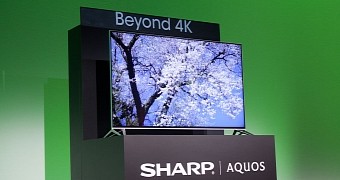Here's a product that will totally run roughshod over HP's reputation as the first company to release a 5K-resolution display. One has to wonder just what kind of evil smiles the people at Sharp throw at each other in secret.
Normally, a display with a native resolution of 3840 x 2160 pixels (4K as it were) has 42 million pixels. A huge number, no doubt about it.
Not huge enough for Sharp though, it turns out. Though perhaps we should have seen it coming, given the company's propensity for uncanny display technologies.
The 13.3-Inch OLED Display with 8K res for notebooks come to mind, though it's far from the only example we could give.
The Sharp 80-Inch Beyond 4K Ultra HD TV
We have the sneaking suspicion that the only reason Sharp didn't call this thing an 8K TV is because the resolution falls just short of it.
8K means 7680 x 4320 pixels, and is a display quality that neither AMD's not NVIDIA's graphics cards can actually reach just yet.
Sharp didn't actually say the resolution of the display gets close to that, but it does specify that instead of the normal 42 million pixels, the TV has 66 million. However, Sharp also calls them sub-pixels, as they result from a technique called pixel splitting.
This leads to a pretty strange irony in which the 80-Inch Beyond 4K Ultra HD TV is still, in the end, “just” a 4K TV for the purposes of classification.
You're still not supposed to play anything in higher resolution (not that there is any content, or much native 4K for that matter).
What the subpixels do is increase the quality and clarity of colors, like some really advanced type of quality graphic enhancement technology.
Speaking of which, the TV also has an integrated upscaling technology which increases the resolution of 1080 content to 4K. It doesn't look as great as native 4K content, but it will tidy you over until TV programs and films in 4K actually spread.
Availability and pricing
Unfortunately, this information was not disclosed, probably because this is just a prototype, like the world's first 4K blu-ray player from Panasonic is just a prototype. Some “normal” 4K TVs of smaller sizes will be reaching stores soon though, if it's any consolation.
43, 50, 55, 60-inch sizes are on the way, starting at $750 / €630. The latter two boast the Android TV platform.

 14 DAY TRIAL //
14 DAY TRIAL //